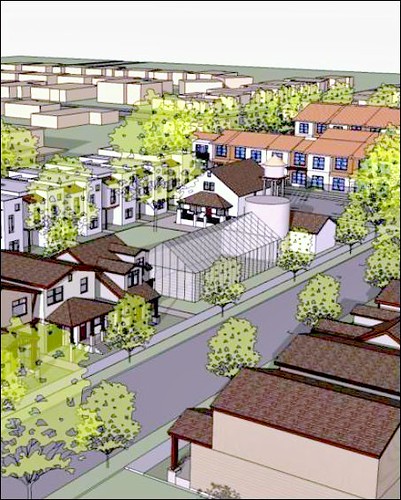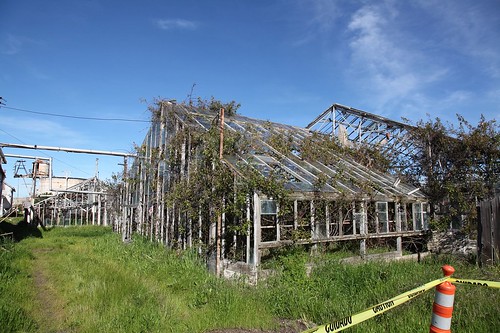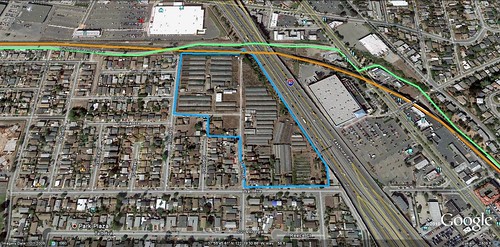How a California city is cleaning up, building green, & protecting residents from pollution

Posted October 6, 2011 at 1:26PM
Over decades, the 14-acre commercial flower nursery in Richmond, California became a severely blighted site, its old greenhouses falling into disrepair and its soil polluted with years of pesticide and herbicide applications. After the nursery closed, contamination posed an obstacle to redevelopment and, to make matters worse, the site abuts the Eastshore (I-80) Freeway, a source of steady traffic that includes trucks emitting diesel soot. Not a great place for housing, one might think.
But think again: these challenges are being overcome as the site is cleaned of contaminants and transformed into what will be the city’s greenest new residential development.
My San Francisco-based colleague Justin Horner has put it this way:
“The Miraflores project is dense, walkable and includes plenty of open space. There’s a significant affordable housing component for seniors,
a mixture of for-sale and rental units, amenities for kids, creek restoration and a significant component dedicated to urban agriculture. There are universally-accessible units for people with disabilities, new bike paths, and plenty of trees and shade.
“And there’s a lot that you can’t see [from looking at the site plan]: the construction debris will be recycled and diverted, there’s on-site renewable energy generation, innovative storm water management strategies to avoid water pollution, and energy-efficient buildings. It’s close to local schools and will use 100% native plantings for all landscaping.
“Oh, and did I mention that it’s also being built on a former brownfield site?”
From the early 1900s, the property was owned by three Japanese-American families who used it to grow flowers, even through the period of internment during World War II. The operation closed in 2006.
The plan for the new development has earned a gold rating under the LEED for Neighborhood Development program developed by the US Green Building Council, the Congress for the New Urbanism, and the Natural Resources Defense Council. When finished, Miraflores will include 160 townhomes, 61 apartments, and 110 affordable senior apartments, plus a four-acre park.  And it will even include some historic preservation: according to a story written by Carolyn Jones in the San Francisco Chronicle, two early 20th-century farmhouses on the site will be preserved and used for community meetings and storage. In addition, two or three legacy greenhouses will be preserved and possibly leased to urban gardeners.
And it will even include some historic preservation: according to a story written by Carolyn Jones in the San Francisco Chronicle, two early 20th-century farmhouses on the site will be preserved and used for community meetings and storage. In addition, two or three legacy greenhouses will be preserved and possibly leased to urban gardeners.
The project is being built by the Richmond Community Redevelopment Agency, with brownfield cleanup and greening assistance from state and federal environmental agencies and development assistance from the environmental nonprofit Global Green USA. Local non-profits, the Community Housing Development Corporation (CHDC) and Eden Housing Inc. were early partners that helped to identify the availability of the property for purchase and worked with the community to determine its reuse.
In several important respects, the property is well situated for green development. It has very good street connectivity, adding to its walkability, and is close to several forms of transit, including a Bay Area Rapid Transit station. Miraflores will be adjacent to a residential neighborhood of mostly bungalows to the west and south, with a commercial area to the north and the freeway to the east. In the satellite image shown with this post, the BART route is marked in orange; the green line marks the Richmond Greenway recreational trail. (Look closely to see how the site has been packed with greenhouses; the image was taken in 2009.) When calculated from a spot in the center of the planned development, its Walk Score is 66, not bad and likely to improve with the influx of over 900 new residents.
But sites that are otherwise well-suited for infill development pose a dilemma for planners when they are adjacent to freeways: Infill development is environmentally preferred whenever possible because it conserves land, enhances walkability, and lowers driving rates compared to conventional suburbs. But the proximity to the freeway can pose a health risk, especially for vulnerable populations, for pulmonary disease caused by breathing particulate emissions from heavy diesel engines.
For Miraflores, planners came up with a win-win solution. Instead of placing homes near the freeway, they created a green buffer zone – a greenbelt of sorts – next to the freeway, moving the homes to the southwest, where there is also maximum connectivity to existing residences as well as routes to nearby schools and places of worship. No home will be within 300 feet of the freeway, and the senior homes will be placed at the farthest distance.
Meanwhile, within the buffer will be a forested area, the daylighted creek, trails, and space for a community garden. Because the garden will grow food on previously contaminated soil, toxic cleanup there will meet a particularly high standard. Very impressive. Occupancy could begin in 2014.
Here’s a news clip from the groundbreaking earlier this year:
Thanks to Ted Bardacke for pointing me to this project.
Move your cursor over the images for credit information.

